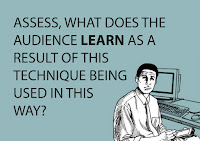Assignment 1 - Advertisement Production for Television (Structures and Techniques)
Learning outcomes
On completion of this unit a learner should:
- Know about the structures and techniques of television advertisements
Spelling & Punctuation
D1 - Comprehensively explain structures and techniques of TV advertisements
with detailed examples and consistently using subject terminology correctly.
with detailed examples and consistently using subject terminology correctly.
Emotional Transfer
Creating a set of emotions that the advertiser is trying to map onto their product or service. The process of generating emotions in order to transfer them to a product. For example, a Coke ad shows happy, beautiful people but tells us nothing about the product. The point is to make you feel good and to transfer that feeling to the brand or product.
This is the number one and most important process of media manipulation.
- often controversial
- exploits emotions
- manipulates emotions
- maps these emotions onto their products
- family values
- friendship
- opportunities for personal identity
- leads to oppositional readings
For example the use of mise-en-scene, in particular the props / costume…
There are connotations of…
The use of close up camera angles…
Exclusive Appeal
Exclusive Appeal is…
Self-image enhancement, ego identification, belongingness and social meaningfulness, effective fulfilment.
The suggestion that the use of the product makes the customer part of an elite group with a luxurious and glamorous lifestyle. A coffee manufacturer shows people dressed in formal gowns and tuxedos drinking their brand at an art gallery.
Self-image enhancement, ego identification, belongingness and social meaningfulness, effective fulfilment.
The suggestion that the use of the product makes the customer part of an elite group with a luxurious and glamorous lifestyle. A coffee manufacturer shows people dressed in formal gowns and tuxedos drinking their brand at an art gallery.
For example the use of mise-en-scene, in particular the props / costume…
There are connotations of…
The use of star power...
Experiential Positioning
Experiential positioning is an attempt to allow the audience to imagine what it would feel like to experience the product. Usually exaggerated, sometimes even hypothetical or metaphorical.
TNT's brand values are probably...
- dramatic / hectic
- fast paced - push the button - symbolic of the TV remote. Immediate. Jump cuts and cutting to soundtrack.
- action packed / lots going on / high octane
- unexpected / chaotic / suspenseful / exciting / never a dull moment
- variety - wide range of different genres shown in trailer (action, romance, crime) (costume)
- comedic / humorous. Slapstick OTT body language.
For example the use of mise-en-scene, in particular the props / costume…
There are connotations of…
Functional Positioning (aka ‘the demo’)
- testimonials
- break the 4th wall
- create comparisons
- pathetic fallacy
- before and afters
- second person narration
- realistic and relatable mise-en-scene
- presenter authority
- usually male midle aged
- repeated slogans
- simplified, scientific domos
- terminology or 'jargon'
In comparison, another example of functional position, or ‘the demo’ might be the Google Pixel advert...
Fear Messages (aka ‘shock tactics’)
Fear messages, or ‘shock tactics’ are...
Shock tactics deliberately attempt to startle or offend audiences by subverting or violating social norms or expectations. Graphic imagery and blunt slogans are used to capture attention and create buzz, and to attract an audience to a certain brand or bring awareness to a certain health issue, or cause. It is often controversial or disturbing.
Shock tactics deliberately attempt to startle or offend audiences by subverting or violating social norms or expectations. Graphic imagery and blunt slogans are used to capture attention and create buzz, and to attract an audience to a certain brand or bring awareness to a certain health issue, or cause. It is often controversial or disturbing.
Surrealism
Surrealism is...
- often nonsensical
- 'anti realist' in narrative
- has a USP
- making a purposeful attempt to be strange
- making an attempt to go viral on social media
- may be an example or personal identity (unique strange humour)
Synthetic Personalisation
Synthetic personalisation is…
- manufactured (synthetic) link
- over-exaggerated characterisation
- often uses mascots
- may be an example or personal identity (favourite childhood characters)
An example of synthetic personalisation might be the ________ advert.
Demographics
What demographics are your adverts aimed at? What age? What gender? What locations?
- GENDER
- AGE
- RACE
- LOCATION
- SEXUALITY
- RELIGION
- SOCIAL STATUS
- ECONOMIC STATUS
(Use this link)
The advert I am looking at is constructed to appeal to the ABC1 / C2DE grouping.
This can be broken down to appeal to dominantly males/females/age/race/locations/sexuality
This can be broken down to appeal to dominantly males/females/age/race/locations/sexuality
It does this by...
What psychographics are your adverts aimed at? Use the Young & Rubicam model (use this link) to identify at least two, & explain why & how…
Audience Gratifications
Young & Rubicam 7 Different Kinds of People
What psychographics are your adverts aimed at? Use the Young & Rubicam model (use this link) to identify at least two, & explain why & how…
The advert I am looking at is constructed to appeal to the .....
It does this by...
Audience Gratifications
What audience uses and gratifications are your adverts aimed at?
Personal Identiy
Personal Relationship
Escapism
Surveillance
Personal Identiy
Personal Relationship
Escapism
Surveillance
Regulation
What Ofcom / ASA Code might have been violated?
Why is this important to consider?
What are the implications?
Why is this important to consider?
What are the implications?



















